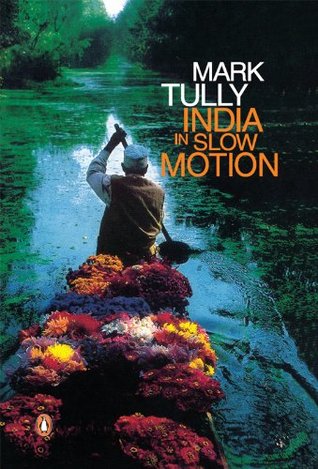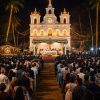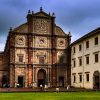Goa is abuzz with excitement as vintage bike and car owners, users, collectors and fans are decking […]

Excerpted from ‘India in Slow Motion’…. ALTERED ALTERS
Book Review, Oct 19 - Oct 25 2019 October 18, 2019I first went to Goa before the tourists got there. It was in in 1967, just six years after what is officially known as the liberation, when the Indian army marched into Goa, ended four hundred and fifty years of Portuguese colonial rule and declared a shotgun marriage between the 7000,000 citizens of the tiny enclave on the Konkan coast and the rest of the vast republic. Although Goa had become part of India and the Portuguese had gone, the church, which had always been an arm of the colonial administration, was still very much a presence.
White cassocks were as regular a sight on the streets of the capital newly renamed Panaji, as black suits and dog collars used to be in Dublin. Congregations on Sunday split out of church doors. The saints and the sacred heart of Jesus looked down from the walls of shops and bars. Goans’ enthusiasm for their church is perhaps surprising because it was fear not faith which original converted them. Father Alexander Valignano, a sixteenth-century Jesuit who served as Visitor of the Province of the East Indies admitted, Conversions were not commonly done by preaching and doctrine but by right methods, as for example preventing idolatry or punishing by merciful rigor those who practised it, denying them such favours as could rightly be denied and conferring such favours on the new converts, honouring, helping, and protecting them, so that the others might be converted with this.’
It was only when threatened by the independence movement across the border in India that the Portuguese government sought allies among the Hindu community by giving hem opportunities which had been almost entirely restricted to Christians.
Over the next twenty-odd years after my first visit, the cassocks disappeared as the priests shed their traditional uniform, but the congregations didn’t seem to diminish and neither did the sacred heart nor the saints. So in the year the Pope had declared holy, the first year, he maintained, of the new millennium, Gilly and I decided to go again to Goa to discover how the church, which had been one of the pillars upholding a colonial regime, could now be a progressive political force in a Goa which was part of independent India.
It’s easy to be misled into thinking that the church still survives and flourishes because four hundred and fifty years of colonial rule turned Goa into a European outpost. Goa was the capital of the Portuguese empire in the east, the seat of one of only six Roman Catholic patriarchs, the longest and the last survivor of Western colonialism in the sub-continent. Those long years have left their imprint, particularly on coastal Goa which was colonized two hundred years before the interior. The white churches, the chapels, the wayside crosses still seen in every coastal village, are the most obvious legacy of the Portuguese. After they left Goa became India’s first international beach tourist resort. It was sold to the charter flight operators as a home away from home, a tiny European enclave in a vast and, for many tourists, all too India, India. An Air India calendar even described Goans as people of Portuguese descent, while one tourist brochure claimed that Goa wasa small replica of Europe’s Latin culture’.
But Goa has a history that stretches back long before 1510 when Afonso de Albuquerque ordered a church to be built on the battlefield where he had won his second and decisive victory against the Muslim rulers of that time. Under Portuguese rule Goa was the headquarters of the mission to convert the Orient, and was often described as the Rome of the East, but earlier it was renowned as the Kashi, or Benares, of the Konkan because it was so sacred to Hindus.
The city which sprang up on the site of Afonso’s victory is now known as Old Goa because the Portuguese moved their capital to Panaji on the coast. The road from the new capital to the old runs alongside the mouth of the Mandovi, crossing a causeway built by the Portuguese. When we drove along the causeway the monsoon rains had swollen the river and the water, coloured dull red by the ore-rich soil of Goa, was seeping into the mangrove swamps and rice fields. In the distance we could see the Western Ghats, the mountains which run for hundreds of miles down the western side of India. It wasn’t long before we entered Old Goa and I was appalled to see the magnificent sixteenth-century Se cathedral was no longer white but a hideous utility yellow. So was the church of St Francis which stands so close to the cathedral that as you approach Old Goa they seem to be one and the same building.
Old Goa is now little more than an ecclesiastical museum, a place of pilgrimage and a tourist destination. The hillside is dotted with churches. Below them, near the banks of the river stands the Viceroy’s Arch, the Portuguese version of the British Gateway of India in Bombay, and the jetty on the River Mandovi where the imperial grandees used to disembark. Opposite the jetty, in the middle of the river, is the small island of Diva dominated by a white church set on a hilltop. Perhaps the Portuguese wanted to demonstrate that they had captured even the smallest of places for Christendom. With churches almost everywhere in coastal Goa, it is easy to forget that throughout Portuguese rule, the majority of Goans remained Hindu and now Hindus were laying claim to a share of the island of Diva, building a temple just below the church to commemorate an ancient image of the elephant god Ganesh. Legend says the image used to stand on that hilltop, until it was removed to safety during the Portuguese war against idolatry.
Loyalty to Portugal never went very deep either. At the height of the decolonizing period, when the Portuguese were condemned by the United Nations and the Non-Aligned Movement for continuous continuing to hold on to Goa, they replied that Goans were not colonial subjects but fully fledged citizens of the motherland, and claimed they were so proud of their citizenship they would die fighting if India invaded. When the Indian army did eventually cross the border in 1961, the Portuguese surrendered without a fight and there was no Goan resistance. But Goan Christians have not cast away their entire Portuguese heritage.
We had gone to Old Goa on a Sunday to attend a mass in the Basilica of Bom Jesus, the shrine of St Francis Xavier, revered by the Roman Catholic church as the Apostle of the Indies and Japan, and the Patrol of Foreign Missions. One of th3 small group who joined St Ignatius Loyola to found the Society of Jesus, he became what I suppose might now be called a religious imperialist, credited by his order with making 7000,000 converts. He regarded the Portuguese government as the secular arm of the church, invited the king to establish the Inquisition in Goa, and was renowned for having no interest in Indian religions or indeed any religion except his own. But attendance at the mass confirmed that he is still Goa’s most popular saint.
When we entered his elaborately carved, brown laterite shrine, we found there was standing room only for the eight o’clock mass. Old Goa now has a very small population and the cathedral is their parish church, and so this congregation must have come from far and wide especially to worship in Bom Jesus. A few elderly ladies covered their heads with black lace, and some of the young girls were dressed up in party frocks with lace-trimmed socks. There was a fair sprinkling of nuns in their habits too. But many of the worshippers had adopted today’s Western informal style of churchgoing. A letter I had read in a parish magazine suggested this had gone too far. The writer complained formodern Goan bimbeties’ coming to mass clad in an all-to-dare-and-bare variety of sexy clothes – tank tops with their midriffs showcase, revealing blouses, hot pants, skimpiest of skirts, sleeveless blouses, baggy jeans etc’ But in front of us a young woman in jeans, which neither bagged nor clung, and a long-sleeved blouse knelt on the stone floor during the consecration.
After the service we joined the long line of worshippers waiting to pay their respects to St Francis Xavier. The queue moved very slowly and so it took some time for us to reach his chapel just below the high alar with its golden reredos, dominated by the figure, not of St Francis Xavier himself, but of his friend St Ignatius Loyola. The marble mausoleum of St Francis took the Florentine sculptor Giovanni Battista Foggini ten years to finish. The mortal remains of the saint are contained in an elaborately carved silver casket, crowned with a cross and placed well out of reach of the faithful, but some did kiss the stone of the mausoleum, while others stood with hands folded staring at the casket, as Hindus do when they have a darshan, standing before an image of one of their gods, gazing in awe, believing they are in the presence of the divine.
After our darshan, we walked through an arch in the south wall, past the sacristy where we could see a priest robing for the next mass, and out into the cloisters where an elderly father dressed in a white cassock sat selling books and pamphlets. He seemed more interested in talking to those who passed by than promoting business, and when he saw us asked the inevitable question,Where are you from?’
After satisfying himself on that point, he took our guide book and opened it at the entry on the Se Cathedal. His face, which bore the marks of a haphazard encounter with a razor, broke into a satisfied smile. He carefully bracketed the words built by the Dominicians’, wrotewrong’ by hem, and then handed the book back saying Everyone makes that mistake. Actually the Dominicians only established themselves here much later, although there were four on Albuquerque’s ships whose job it was to sing Te Deums.’
I told him a story about his society I’d heard many years ago from an Irish secular priest. There had been a great convocation of all the orders held on the top of Mount Sinai to try to resolve the rivalry between them. The Superiors of the orders knelt in a circle and prayed, asking God to let them know which of them he regarded most highly. After long hours of prayer a dove descended and dropped a message from her beak. The Jesuit General managed to pick it up first and read out,You are all equal in my sight. Signed God, Society of Jesus.’
The old priest roared with laughter. Yes, the other clergy here do say that we are arrogant, but the people love St Francis Xavier you know and, as I told you, he was Jesuit, and so we are popular with them. You can see they come here in large numbers to make their confessions to us.’ He paused for a moment to make sure that the nun sitting next to him wasn’t listening, leaned forward and in a conspiratorial stage whisper, said,Mind you, I do sometimes think many come because they have something they want to confess to a strange priest rather than the parish priest who knows them.’
To bring the subject round to the Portuguese influence on the church, I asked how much still survived. Sometimes you do still find someone confessing to you in Portuguese. But most of the priests can’t understand the language any more. The only foreign language they know is English. We have exchanged Portuguese colonialism for yours.’
The Roman Catholic church is now trying to shake off all colonial influences and become manifestly an Indian church. This movement is known by the rather ugly word – enculturalization. The elderly Goan Jesuit thought it was all a bit overdone.What do we need enculturalization for?’ he asked scornfully. We do have always had a lot of Hinduism, if that’s what you mean by it, in Goan Catholicism. Many customs which still go on, and have gone on for long before I can remember, are very Indian. Take for instance at this time of the year – because there is no work in the fields, whole villages of Hindus re making pilgrimages to temples and Christians are, in the same way, making pilgrimages here to Bom Jesus. Then again, young couples bring their children here to cut off a lock of their hair just like Hindu children are taken to river banks or the seashore to have their heads shaved.’
The Portuguese did their best to dig up those Indian roots. An edict of the Inquisition published in 1736, more than two hundred years after the Portuguese established Christianity in Goa, prohibited specific Hindu practices creeping into Catholicism. Anointing brides and bridegrooms with mixture of milk and coconut oil, or touching their foreheads with grains of raw rice were banned from marriage rites. After a death the walls of a house were not to be plastered with cow dung, and the clothes of the dead person were not to be thrown into a river or the sea, which are sacred to Hindus. If it were necessary to destroy them to avoid contagion they should be burnt. The living were strictly prohibited from wearingHindu clothes’.
Even when the Portuguese left it took the Vatican a long time to accept that the Goan church must be Indian. The Portuguese Patriarch who had written to his clergy on some sixty occasions urging them to remember that it was their duty to obey the Portuguese administration, didn’t leave with the governor general. He stayed on until Vatican Two made his position well-nigh impossible. Even then Rome did not feel able to trust Goans fully. A Goan, Francisco Xavier da Pidade Rebello, who was a safe choice as he was closely identified with the Portuguese church due to his years of service in the Patriarchal Cuia, was consecrated bishop but only appointed administrator apostolic. The See of Goa was kept vacant. It wasn’t until 1978 that Goans once again had an archbishop, and the titles Primate of the East and Patriarch of the East Indies were restored.
The Vatican feared that Goans, if they were given full charge of their own church, would allow Hinduism, with its long history of syncretism, to seep into the orthodox faith the Portuguese had preserved. From Rome it was not possible to see that a measure of syncretism was essential if the church was to flourish in its new surroundings. But that was clear to the Society of Pilar, a society of priests founded in Goa which does not have its headquarters in Rome, as the Jesuits do.
The headquarters of the Society of Pilar, some ten kilometres inland from Old Goa, is approached by a road winding up a hill, past a school of music, an industrial training school and other buildings indicating the extent of the Pilar fathers’ activities. The road ends at another white Portuguese church. Beyond it stands a modern office block known, rather formidably, as the Generalate, and at the very top of the hill is the seminary overlooking the mouth of Goa’s other great river, the Zuari, and the port of Marmagoa. The older fathers remember going up to the roof to watch Indian planes bombing shipping during the `liberation’, which must have been something of an overkill bearing in mind the Portuguese lack of resistance.















